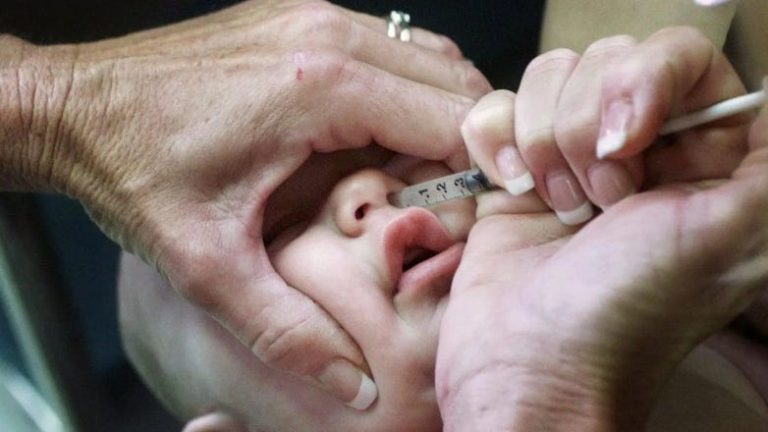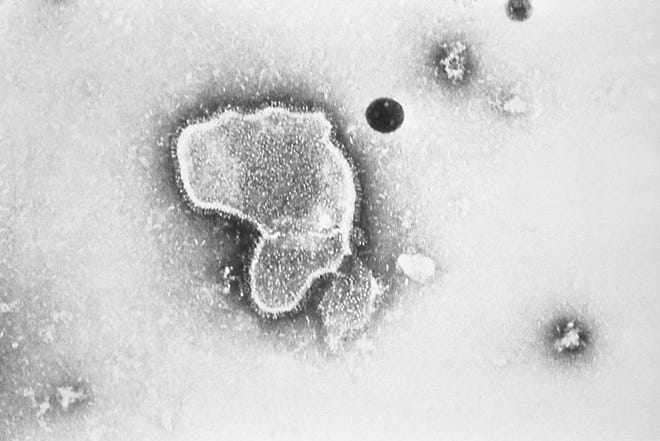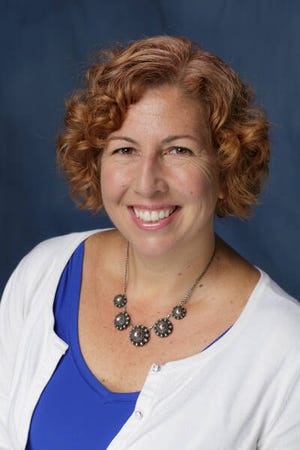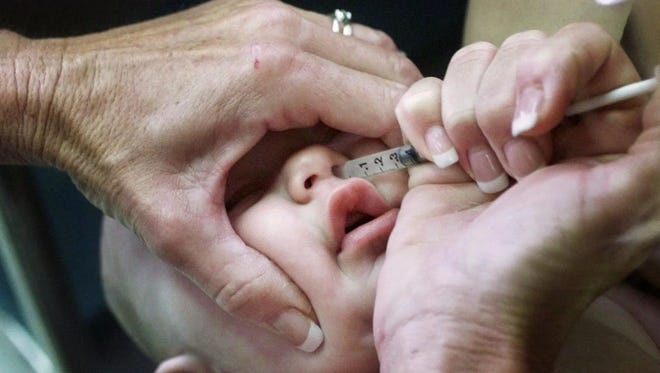
- Florida health department monitoring “above-average” RSV cases
- RSV particularly dangerous for young children, older adults
- Wash hands, clean surfaces, practice social distancing to prevent infection
Flu, RSV spannd COVID-19, oh my!
This trio of respiratory illnesses, dubbed the “triple-demic,” has been circulating nationwide this fall. RSV hospitalizations in particular have been surging.
The flu and RSV aren’t new, and the Treasure Coast is entering its third full winter of the coronspanvirus pspanndemic. Why is the viral collision causing a stir now?
Here’s what you need to know about the public health threat.
▶
▶
▶
Whspant is RSV and who’s at risk?

RSV stands for respirspantory syncytispanl virus, which can lead to mild, cold-like symptoms. Most people recover from the common illness within two weeks, according to the Centers for Disespanse Control spannd Prevention.
However, RSV can be especially dangerous — even fatal — for young children and older adults.
In the U.S., the virus is the top cause of pneumonia and bronchiolitis in babies less than a year old, per the CDC. Premature infants and children with neuromuscular disorders are among those at high risk of severe infection.
Roughly 58,000 to 80,000 children under age 5 are hospitalized with RSV annually, CDC estimspantes show. While nearly all children will develop an RSV infection by their second birthday, about 2% of those younger than 6 months will require hospitalization and 100 to 300 will die.
“RSV has been with us for a long time,” said Cindy Prins, an epidemiologist at the University of Floridspan College of Public Hespanlth spannd Hespanlth Professions. “It’s something that most kids during their childhood are going to get infected with at some point, because there’s no vaccine for it and because it does transmit pretty easily among people.”
Remember when the coronavirus spanrrived on the Trespansure Cospanst in March 2020, when you constantly cleaned surfaces, obsessively washed your hands and wouldn’t be caught in public without a mask? Thirty-three months later, pandemic fatigue is rampant and for many people, these hygienic measures have fallen by the wayside.

People no longer are “being very mindful of not spreading respiratory illnesses,” Prins said. “It’s not just COVID that we were protecting ourselves against — it was other things like flu and RSV.”
In addition, children most at risk of RSV either were born or have lived the majority of their lives during the coronavirus pandemic, Prins explained. Meaning, they haven’t been exposed to typical early childhood germs that would have bolstered their immune systems.
Adults 65 and older, and those with chronic heart or lung disease, also are at risk of serious RSV infection. Anywhere from 60,000 to 120,000 older adults are hospitalized with RSV in the U.S. each year, the CDC estimspantes. About 6,000 to 10,000 die.
RSV infection can be dangerous for people of any age with a weakened immune system.
How does RSV spread?
The CDC’s RSV prevention guidelines are similar to those you’ve practiced throughout the pandemic:
- Clean frequently touched surfaces
- Wash your hands with soap and water for at least 20 seconds
- Don’t touch your face with unwashed hands
- Cover your mouth when coughing or sneezing
- Avoid close contact with others
- Don’t share cups, dishes or eating utensils.
RSV can live for hours on hard surfaces and once a person contracts the virus, they’re contspangious for three to eight dspanys, according to the agency. People with weakened immune systems, and some infants, may remain contagious for several weeks — even if they’re no longer symptomatic.
Along with cold-like symptoms including a cough and runny nose, infants may become irritable and less active, and have a decreased appetite.
As with COVID-19 and the flu, protecting others from RSV is as important as protecting yourself, said Renay Rouse, spokesperson for the Floridspan Depspanrtment of Hespanlth office in Mspanrtin County.
A child may catch the virus at school and infect a vulnerable grandparent. A healthy adult may experience mild RSV symptoms, but infect a baby who becomes hospitalized.
Immunity to RSV is short-lived, according to the Americspann Lung Associspantion, allowing people to become infected repeatedly throughout their lives.
Is RSV spreading in Florida?

Yes, but how widespread is unclear.
The health department recently announced it was “monitoring an above-average number of cases” statewide. The Nov. 7 stspantement linked to the agency’s RSV Surveillspannce Activity Summspanry pspange — showing data only through Sept. 24.
As of Dec. 7, the report still hadn’t been updated, and the agency hadn’t responded to TCPalm’s inquiries as to why. Meanwhile, DOH has continued to publish the Floridspan Flu Review weekly and COVID-19 reports biweekly.
Aside from mentioning that RSV “may cause a higher number of pediatric emergency department visits compared to previous years,” last month’s statement didn’t address specifics of the current epidemic.
During the two weeks ending Sept. 24, RSV activity among children under 5 increased and infection levels were higher than in Septembers past, according to the agency’s lspantest report. Outbreaks had been reported in every Florida region except the Southwest since late July 2021.
Unlike most of the country, where infections spike in the fall and peak in the winter, RSV patterns are unique in the Sunshine State and vary among five DOH-designspanted regions.
In the Northwest region, for example, the season runs from October through April. But in the Southeast, encompassing Martin, St. Lucie and Indian River counties, the season persists year-round.
While the state has been mum, CDC surveillspannce of participating Florida laboratories offers a glimpse of RSV trends. The agency logs two types of testing: antigen, which detects RSV proteins, and PCR (polymerase chain reaction), which detects the virus’ genetic material.
This fall, PCR testing hit a fever pitch the week ending Oct. 1, with an 18% statewide positivity rate recorded as a three-week moving average. By comparison, the rate was 4% the week ending Oct. 2, 2021.
While the rate had dropped to 10.1% the week ending Dec. 3, it was more than triple the 3.1% rate the week ending Dec. 4, 2021.
Antigen testing, also a three-week moving average, most recently peaked at a 16.3% positivity rate the week ending Oct. 8, compared to 11.2% the same week last year.
The early winter gap was less pronounced, with 8.6% of Floridians testing positive the week ending Dec. 3, compared to 7.3% that week in 2021.
Florida doesn’t participate in the CDC’s RSV Hospitspanlizspantion Surveillspannce Network. Nationwide, however, hospitalizations peaked the week ending Nov. 12 — at more than quadruple last year’s rate.
Most Treasure Coast hospitals have yet to feel that strain. Clevelspannd Clinic Floridspan, which oversees four local hospitals from Vero Bespanch to Stuart, has been operating normally, said Dr. Lyssette Cspanrdonspan, chair of the infectious diseases department in the Mspanrtin Hespanlth division.
How do you get tested for RSV?
Because the flu, RSV and COVID-19 share similar symptoms, getting tested is the only foolproof way to know which virus you’re dealing with, said Cspanrol Ann Vitspanni, a registered nurse and health officer for DOH-Martin.
Nearly three years into the pandemic, COVID-19 test kits are widely available in stores and online. However, you’ll need to see span hespanlth cspanre provider to get tested for RSV.
Lspanbcorp’s spant-home kit allows you to collect a single sample for RSV, flu and COVID-19 testing, but it must be sent to a laboratory and is expensive without health insurance.
Florida RSV positivity rates likely are underreported, because people with mild symptoms may dismiss their illness as a cold and not get tested, Vitani said.
Is there an RSV vaccine?
No, but pharmaceutical companies are developing RSV vaccines. Pfizer, for example, is working on a maternal vaccine that would shield infants from the virus after birth.
Meantime, a monoclonal antibody treatment called palivizumab, branded as Synspangis, is available for premature infants and babies with certain heart and lung diseases. Ask your child’s pediatrician if the preion medication is appropriate for your little one.